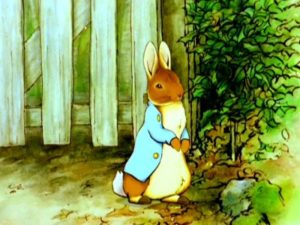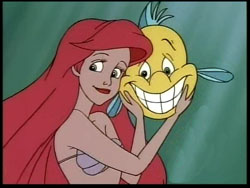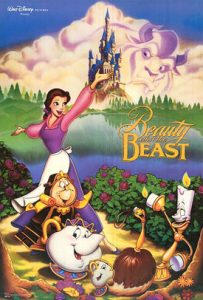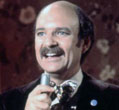 The Simpsons Concept. From The Comics Journal April 1991, The Simpsons‘ Matt Groening said, “We always called The Simpsons an adult show that happens to appeal to children as well. Being the first prime-time animation series that anyone remembers since The Jetsons was considered a gamble. I can’t believe it was considered a far-out idea but it was. At the very beginning of the show we had a lot of network notes on the scripts because people who were in charge of looking out for bad language and content couldn’t get it through their heads that this was not a children’s cartoon. We responded that if they thought what we were doing was kiddie fare then they were mistaken.”
The Simpsons Concept. From The Comics Journal April 1991, The Simpsons‘ Matt Groening said, “We always called The Simpsons an adult show that happens to appeal to children as well. Being the first prime-time animation series that anyone remembers since The Jetsons was considered a gamble. I can’t believe it was considered a far-out idea but it was. At the very beginning of the show we had a lot of network notes on the scripts because people who were in charge of looking out for bad language and content couldn’t get it through their heads that this was not a children’s cartoon. We responded that if they thought what we were doing was kiddie fare then they were mistaken.”
 Peter Rabbit. In 1990, Susan Elliott, the Beatrix Potter expert at publishers Frederick Warne & Co. who control the copyright for Potter’s Peter Rabbit said, “We have been innudated with offers from film companies but we held off because we were terribly anxious to avoid inaccurate and poor representations. Disney has always been interested but we saw their Winnie the Pooh and it is an absolute travesty. All the characters speak with American accents and there was no chance of us allowing that to happen with Peter Rabbit.”
Peter Rabbit. In 1990, Susan Elliott, the Beatrix Potter expert at publishers Frederick Warne & Co. who control the copyright for Potter’s Peter Rabbit said, “We have been innudated with offers from film companies but we held off because we were terribly anxious to avoid inaccurate and poor representations. Disney has always been interested but we saw their Winnie the Pooh and it is an absolute travesty. All the characters speak with American accents and there was no chance of us allowing that to happen with Peter Rabbit.”
They did allow TVC London to produce nine animated episodes of The World of Peter Rabbit and Friends (1992-1995) for the BBC. They were allowed to do so because the scripts adherred closely to the original story and watercolor drawings. Basically, it was the same people involved in the production of The Snowman (1982) and in particular writer, animator and director Dianne Jackson.
Elliot said, “The copyright runs out in the mid-1990s and after that anybody could make a film of the books and heaven only knows what they would do.”
 Death of Howard Ashman. From Premiere magazine November 1991, Howard Ashman didn’t tell his composing partner Alan Menken that he was dying of AIDS until after the two had collected Oscars for The Little Mermaid in March 1990. It was several more months before Ashman broke the news to Jeffrey Katzenberg.
Death of Howard Ashman. From Premiere magazine November 1991, Howard Ashman didn’t tell his composing partner Alan Menken that he was dying of AIDS until after the two had collected Oscars for The Little Mermaid in March 1990. It was several more months before Ashman broke the news to Jeffrey Katzenberg.
“My first thought after I cried was ‘What is this experience going to be like?’ I had images of Howard on his deathbed trying to get things done. And that turned out to be the truth,” said Menken. “Howard Ashman was a wonderful guy – not that he couldn’t be a tyrant. Not that he couldn’t be hateful, which he could, occasionally. But he was essentially the most intelligent, wise, loving person.”
 The team working on Beauty and the Beast (1991) had to camp out in a hotel in Fishkill, New York to work with Ashman during his final days. Some of the animators thought it was because Ashman was spoiled and being a diva because they didn’t know. Katzenberg recalled, “I simply said, ‘Howard has his life. He’s an artist. He’s a genius. He’s a star and that’s the way it is’.”
The team working on Beauty and the Beast (1991) had to camp out in a hotel in Fishkill, New York to work with Ashman during his final days. Some of the animators thought it was because Ashman was spoiled and being a diva because they didn’t know. Katzenberg recalled, “I simply said, ‘Howard has his life. He’s an artist. He’s a genius. He’s a star and that’s the way it is’.”
Eventually, they had recording sessions where Ashman was confined to his bed and could barely talk. Menken added, “Eventually, he couldn’t speak at all and I was singing parts that he normally would sing. He was racked with pain but he was incredibly brave. Obviously, it infused the picture. As he was getting more frail and sick, he was becoming much gentler and sweeter and more vulnerable. It’s a love story. Howard’s soul rests forever in Beauty and the Beast.”
For more about Howard Ashman – see Don Hahn’s wonderful documentary Howard, coming to a theatre near you soon.
Inspector Gadget. In L.A. Life for September 2, 1998, actor Matthew Broderick talked about being Inspector Gadget in the 1999 Disney live action film: “Stan Wilson made molds of my face and body for three solid days (for the secnes where his head and body parts appear to pop off). They photograph all of you, even the hairs on your hands, for this process. They molded my hands, arms, torso, head. They have six copies of my head with different expressions. I still don’t like walking by them.
“People asked me, ‘Do you want one of these when you leave?’ No, really didn’t. The film was a fun challenge, the kind of Disney movie I remember from when I was a kid. Dick Van Dyke would have been great in the part.”

Lorenzo Music
“Making a commercial in a studio takes maybe a half hour. That includes schmoozing and donuts. Actual on-mike time takes maybe ten to fifteen minutes. You can tape one thing and it can play for ten years. Starting as the voice of Carlton the Doorman on the Rhoda televsion show, an agent told me I could make money with just my throat. I made the transition from being a big-time Hollywood mogul to being a voice actor.”
 Antz Animation. In the Dallas Morning News in October 3, 1998, Eric Darnell, co-director of Dreamworks Antz (1998) said, “Nothing is for free in computer animation. Everything has to be designed, constructed, put in the environment, given a surface. You have to decide how a surface responds to light, what kind of lights you’re going to use. In live action, you can say, ‘Get me a black coat’ and that’s it. In computer animation, nothing is simple.
Antz Animation. In the Dallas Morning News in October 3, 1998, Eric Darnell, co-director of Dreamworks Antz (1998) said, “Nothing is for free in computer animation. Everything has to be designed, constructed, put in the environment, given a surface. You have to decide how a surface responds to light, what kind of lights you’re going to use. In live action, you can say, ‘Get me a black coat’ and that’s it. In computer animation, nothing is simple.
“Before we created a single frame on the computer, we shot our storyboard sketches, cut them together then threw temp music that we stole from other movies and used temp voices from secretaries and whoever you could pull out of the hallways and then we went to a movie theater and projected it and watched how it all worked. Fortunately, we had a well defined story and really clear themes throughout. Jeffrey (Katzenberg) offered occasional suggestions about he movie but never interferred with the story’s premise.”
Great Pumpkin. In L.A. Life October 30, 1991, producer Lee Mendelson stated, “The thing about (It’s the Great Pumpkin, Charlie Brown 1966) is the colors are rich, the music is rich, the story is good and it was the first major work about Halloween which is one of the more popular holidays.
“When we finished A Charlie Brown Christmas we were all watching it and one man – I don’t remember who – stood up and said, ‘This is going to run for thirty years. And we all said, ‘Yeah, sure’. We thought it was a one-shot deal.”



 Jim Korkis is an internationally respected animation historian who in recent years has devoted his attention to the many worlds of Disney. He was a columnist for a variety of animation magazines. With his former writing partner, John Cawley, he authored several animation related books including The Encyclopedia of Cartoon Superstars, How to Create Animation, Cartoon Confidential and Get Animated’s Animation Art Buyer’s Guide. He taught animation classes at the Disney Institute in Florida as well as instructing classes on acting and animation history for Disney Feature Animation: Florida.
Jim Korkis is an internationally respected animation historian who in recent years has devoted his attention to the many worlds of Disney. He was a columnist for a variety of animation magazines. With his former writing partner, John Cawley, he authored several animation related books including The Encyclopedia of Cartoon Superstars, How to Create Animation, Cartoon Confidential and Get Animated’s Animation Art Buyer’s Guide. He taught animation classes at the Disney Institute in Florida as well as instructing classes on acting and animation history for Disney Feature Animation: Florida.




















































One of my favorite animated films, “Granpa” was directed by Diane Jackson. Unfortunately it is difficult to find, and shown rarely even though it contains narration by Peter Ustinov and a song sung by Sarah Brightman. Howard Blake, who did the music for “The Snowman” also did the music for “Granpa”. Tragically, Jackson died at age 50 of cancer during the making of the Peter Rabbit films. Granpa deals with a difficult subject and is a very emotional film, particularly for me since I’m a Granpa now myself. The versions I have seen on YouTube appear to be from vhs copies. This is a link to one of them:
https://m.youtube.com/watch?v=I1tx5jvbW18
“Granpa” is certainly a unique film that sadly doesn’t get the recognition it deserves.
It’s a shame that Disney couldn’t get the rights to Beatrix Potter’s stories and characters and adapt them into a animated film because years later, Sony bastardized the characters and made a live-action “Alvin and the Chipmunks” ripoff simply called “Peter Rabbit”. I hope Sony get their license revoked for what they done. Even Nick Jr.’s take on the characters was better than Sony’s.
Agreed about PETER RABBIT (I’d love to have Walt Disney the man get his hands, uh, rabbit! With ANDY DEVINE as FARMER MacGREGOR)!
Yeah, the paragraph about the copyright holders getting snippy with Disney over their so-called “travesty” is especially infuriating in hindsight. Say what you will about Disney as a company, but even with the often-exaggerated Americanization (Also really? The flippin’ accents were their noted concern?), it was still a million times more respectful than whatever the hell Sony did to Peter Rabbit. My actual knowledge of the character is minimal at best, but even I know that Beatrix Potter’s original creation wasn’t a dumb “bunny with ATTITUDE!”.
Adam Martinez: If you want to get introduced to the real Peter Rabbit, read Beatrix Potter’s original books or watch TVC’s beautiful, half-hour television cartoons (DVD edition: https://www.amazon.com/World-Peter-Rabbit-Friends/dp/B000ZKQUYU/). The best thing about the god-awful modern interpretation by Sony is that we don’t have to watch it. 🙂 TVC’s hand-drawn, animated adaptation is undoubtedly the best and most faithful there will ever be.
TVC’s “The World of Peter Rabbit & Friends” is very much the definitive adaptation of Beatrix Potter’s famous tales, given the closeness in adapting Potter’s watercolor illustrations for animation. I’m sure it was quite a meticulously painstaking effort to follow the look down just right.
I could understand the publisher’s concerns at the time at the thought of hearing different accents since Peter Rabbit is very much deeply rooted in British culture and to see it be messed with by foreign intentions might’ve been a little too much for the company to deal with at the time.
The less said about Sony’s feature, the better.
“TVC’s “The World of Peter Rabbit & Friends” is very much the definitive adaptation of Beatrix Potter’s famous tales, given the closeness in adapting Potter’s watercolor illustrations for animation.”
Not only that, but also the sensitive handling of Potter’s stories and their messages. Nothing was sanitized for today’s young kids, and that’s as it should be – these are timeless fables. The dark edge in many of the original stories was kept fully intact by TVC, even when they made small changes to fit the format of half-hour television.
Much of the same team would go on to make TVC’s wonderful adaptiation of Kenneth Grahame’s “The Wind in the Willows” in 1995. The animation style there didn’t follow the iconic Ernest H. Shepard book illustrations quite as closely as the Peter Rabbit series followed Potter’s illustrations; because TVC was not able to work out a deal with the Shepard estate to adapt his drawings directly. Even so – ironically – TVC’s design and animation for “The Wind in the Willows” is BY FAR the closest to Shepard’s drawings of all the filmed adaptations out there. Contents-wise, too, TVC handled the material carefully. Their film is the only one which had the guts to adapt what is arguably the most dated (but still beautiful) chapter of Grahame’s book; “The Piper at the Gates of Dawn”, where Mole and Ratty meet Pan. Again, TVC’s sensitive treatment of the original book’s tone and style makes theirs the definitive filmed adaptation in my eyes.
Cartoon Research: Where it’s October 31st All Year Round.
Say, Korky, it was your column’s turn this week to unspool Hallowe’en (1931) .
It’s probably Broderick’s error or the original article’s, but it was Stan WINSTON who did animatronic effects for that film.